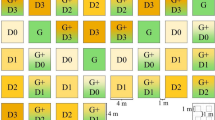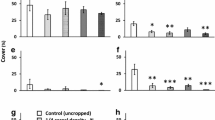Abstract
Wildflower strips (WS) are proposed in many European countries as a strategy to enhance biodiversity and ecosystem services in arable fields. To create and maintain WS on nutrient-rich cultivated soils reveals challenging. Flowered species may be outcompeted by grasses due to high phosphorus content in soil. We studied during 5 years seed mixture (grass density in the seed mix) and mowing regime influenced the ability of WS to provide environmental benefits (flower provision for insects and landscape purposes, reduction of soil nutrient load) and respond to farmer concerns (noxious weed promotion, forage production). Lowered grass density increased flower abundance, but not diversity, only in the first 3 years. In the last 2 years mowing effects became determinant. Flower cover and richness were the highest under the twice-a-year mowing regime. This regime also increased forage quantity and quality. Flower colour diversity was conversely the highest where mowing occurred every two years. Potassium in the soil decreased under the twice-a-year mowing regime. Other nutrients were not affected. No management option kept noxious weed to an acceptable level after 5 years. This supports the need to test the efficacy of specific management practices such as selective clipping or spraying. Mowing WS twice a year was retained as the most favourable treatment to maintain species-rich strips with an abundant flower provision. It however implies to mow in late June, i.e. at the peak of insect abundance. It is therefore suggested to keep an unmown refuge zone when applying this management regime.

Similar content being viewed by others
References
Albrecht H (2005) Development of arable weed seedbanks during the 6 years after the change from conventional to organic farming. Weed Res 45:339–350. https://doi.org/10.1111/j.1365-3180.2005.00472.x
Asteraki EJ, Hart BJ, Ings TC, Manley WJ (2004) Factors influencing the plant and invertebrate diversity of arable field margins Agric Ecosyst Environ. 102:219–231. https://doi.org/10.1016/j.agee.2003.07.003
Batáry P, Dicks LV, Kleijn D, Sutherland WJ (2015) The role of agri-environment schemes in conservation and environmental management. Conserv Biol 29:1006–1016. https://doi.org/10.1111/cobi.12536
Bremner JM (1965) Inorganic Forms of Nitrogen. In: Black CA (Ed.) Methods of soils analysis. Part2. American Society of Agronomy, Madison, WI, USA, pp 1179–1237
Bruinenberg MH, Valk H, Korevaar H, Struik PC (2002) Factors affecting digestibility of temperate forages from seminatural grasslands: a review. Grass Forage Sci 57:292–301
Buri P, Humbert JY, Arlettaz R (2014) Promoting pollinating insects in intensive agricultural matrices: field-scale experimental manipulation of hay-meadow mowing regimes and its effects on bees. PLoS ONE 9:e85635. https://doi.org/10.1371/journal.pone.0085635
Critchley CNR, Chambers BJ, Fowbert JA, Bhogal A, Rose SC, Sanderson RA (2002) Plant species richness, functional type and soil properties of grasslands and allied vegetation in English Environmentally Sensitive Areas. Grass Forage Sci 57:82–92. https://doi.org/10.1046/j.1365-2494.2002.00305.x
Cruz P, Duru M, Therond O, Theau JP, Ducourtieux C (2002) Une nouvelle approche pour caractériser les prairies naturelles et leur valeur d ’ usage. Fourragees 172:335–354
De Cauwer B, Reheul D, Nijs I, Milbau A (2006a) Dry matter yield and herbage quality of field margin vegetation as a function of vegetation development and management regime. NJAS - Wagening J Life Sci 54:37–60. https://doi.org/10.1016/S1573-5214(06)80003-5
De Cauwer B, Reheul D, Nijs I, Milbau A (2006b) Effect of margin strips on soil mineral nitrogen and plant biodiversity. Agron Sustain Dev 26:117–126. https://doi.org/10.1051/agro:2006004
De Cauwer B, Reheul D, Nijs I, Milbau A (2008) Management of newly established field margins on nutrient-rich soil to reduce weed spread and seed rain into adjacent crops. Weed Res 48:102–112. https://doi.org/10.1111/j.1365-3180.2007.00607.x
Denys C, Tscharntke T (2002) Plant-insect communities and predator-prey ratios in field margin strips, adjacent crop fields, and fallows. Oecologia 130:315–324. https://doi.org/10.1007/s004420100796
Ebeling A, Klein AM, Schumacher J, Weisser WW, Tscharntke T (2008) How does plant richness affect pollinator richness and temporal stability of flower visits? Oikos 117:1808–1815. https://doi.org/10.1111/j.1600-0706.2008.16819.x
Fründ J, Linsenmair KE, Blüthgen N (2010) Pollinator diversity and specialization in relation to flower diversity. Oikos 119:1581–1590. https://doi.org/10.1111/j.1600-0706.2010.18450.x
Gardarin A, Garnier É, Carrère P et al. (2014) Plant trait-digestibility relationships across management and climate gradients in permanent grasslands. J Appl Ecol 51:1207–1217. https://doi.org/10.1111/1365-2664.12293
Guiot J (1975) Estimation des reserves azotees du sol par determination de l’azote mineral. Rev l’Agriculture 28:1117–1132
Haaland C, Naisbit RE, Bersier LF (2011) Sown wildflower strips for insect conservation: a review. Insect Conserv Divers 4:60–80. https://doi.org/10.1111/j.1752-4598.2010.00098.x
Halling MA, Topp CFE, Doyle CJ (2004) Aspects of the productivity of forage legumes in Northern Europe. Grass Forage Sci 59:331–344. https://doi.org/10.1111/j.1365-2494.2004.00435.x
Hansson M, Fogelfors H (1998) Management of permanent set-aside on arable land in Sweden. J Appl Ecol 35:758–771. https://doi.org/10.1046/j.1365-2664.1998.355350.x
Hatt S, Uyttenbroeck R, Lopes T, Mouchon P, Chen J, Piqueray J, Monty A, Francis F (2017) Do flower mixtures with high functional diversity enhance aphid predators in wildflower strips? Eur J Entomol 114:66–76. https://doi.org/10.14411/eje.2017.010
Hatt S, Uyttenbroeck R, Lopes T, Chen JL, Piqueray J, Monty A, Francis F (2018) Effect of flower traits and hosts on the abundance of parasitoids in perennial multiple species wildflower strips sown within oilseed rape (Brassica napus) crops. Arthropod Plant Interact 12:787–797. https://doi.org/10.1007/s11829-017-9567-8
Humbert JY, Ghazoul J, Richner N, Walter T (2012a) Uncut grass refuges mitigate the impact of mechanical meadow harvesting on orthopterans. Biol Conserv 152:96–101. https://doi.org/10.1016/j.biocon.2012.03.015
Humbert JY, Pellet J, Buri P, Arlettaz R (2012b) Does delaying the first mowing date benefit biodiversity in meadowland? Environ Evid 1:9
Janssens F, Peeters A, Tallowin JRB, Bakker JP, Bekker RM, Fillat F, Oomes MJM (1998) Relationship between soil chemical factors and grassland diversity. Plant Soil 202:69–78. https://doi.org/10.1023/A:1004389614865
Junge X, Schüpbach B, Walter T, Schmid B, Lindemann-Matthies P (2015) Aesthetic quality of agricultural landscape elements in different seasonal stages in Switzerland. Landsc Urban Plan 133:67–77. https://doi.org/10.1016/j.landurbplan.2014.09.010
Kahmen S, Poschlod P, Schreiber KF (2002) Conservation management of calcareous grasslands. Changes in plant species composition and response of functional traits during 25 years. Biol Conserv 104:319–328. https://doi.org/10.1016/S0006-3207(01)00197-5
Kayser M, Isselstein J (2005) Potassium cycling and losses in grassland systems: a review. Grass Forage Sci 60:213–224
Kiehl K, Pfadenhauer J (2007) Establishment and persistence of target species in newly created calcareous grasslands on former arable fields. Plant Ecol 189:31–48. https://doi.org/10.1007/s11258-006-9164-x
Kirmer A, Rydgren K, Tischew S (2018) Smart management is key for successful diversification of field margins in highly productive farmland. Agric Ecosyst Environ 251:88–98. https://doi.org/10.1016/j.agee.2017.09.028
Kleijn D, Raemakers I (2008) A retrospective analysis of pollen host plant use by stable and declining bumble bee species. Ecology 89:1811–1823. https://doi.org/10.1890/07-1275.1
Lakanen E, Erviö R (1971) A comparison of eight extractants for the determination of plant available micronutrients in soils. Acta Agric Fenn 123:223–232
Landis DA, Wratten SD, Gurr GM (2000) Habitat Management to Conserve Natural Enemies of Arthropod Pests in Agriculture. Annu Rev Entomol 45:175–201. https://doi.org/10.1146/annurev.ento.45.1.175
Lebeau J, Wesselingh RA, Van Dyck H (2015) Butterfly density and behaviour in uncut hay meadow strips: behavioural ecological consequences of an agri-environmental scheme. PLoS ONE 10:e0134945. https://doi.org/10.1371/journal.pone.0134945
Marrs RH (1993) Soil fertility and nature conservation in Europe: theorical considerations and practical management solutions. In: Begon M, Fitter AH (eds) Advances in ecological research 24. Harcourt Brace & Company, London, pp 241–300
Marrs AJO, Lakhani KH, Kirkham FW, Ecology A (2016) Experimental assessment of the effects of nitrogen addition under hay- cutting and aftermath grazing on the vegetation of meadows on a Somerset Peat Moor. J Appl Ecol 30:321–332
Nicholls CI, Altieri MA (2013) Plant biodiversity enhances bees and other insect pollinators in agroecosystems. A review. Agron Sustain Dev 33:257–274. https://doi.org/10.1007/s13593-012-0092-y
Oelmann Y, Kreutziger Y, Temperton VM, Buchmann N, Roscher C, Schumacher J, Schulze E-D, Weisser WW, Wilcke W (2007) Nitrogen and phosphorus budgets in experimental grasslands of variable diversity. J Environ Qual 36:396. https://doi.org/10.2134/jeq2006.0217
Piqueray J, Mahy G (2010) Revue bibliographique sur la restauration des pelouses calcicoles en Europe: Contraintes rencontrées et solutions proposes. Biotechnol Agron Soc Environ 14:471–484
Piqueray J, Rouxhet S, Hendrickx S, Mahy G (2016) Changes in the vegetation of hay meadows under an agri-environment scheme in South Belgium. Conserv Evid 13:47–50
Ridding LE, Redhead JW, Pywel RF (2015) Fate of semi-natural grassland in England between 1960 and 2013: a test of national conservation policy. Glob Ecol Conserv 4:516–525. https://doi.org/10.1016/j.gecco.2015.10.004
Rundlöf M, Persson AS, Smith HG, Bommarco R (2014) Late-season mass-flowering red clover increases bumble bee queen and male densities. Biol Conserv 172:138–145. https://doi.org/10.1016/j.biocon.2014.02.027
Sattler C, Nagel UJ (2010) Factors affecting farmers’ acceptance of conservation measures-A case study from north-eastern Germany. Land Use Policy 27:70–77. https://doi.org/10.1016/j.landusepol.2008.02.002
Schellberg J, Möseler BM, Kühbauch W, Rademacher IF (1999) Long-term effects of fertilizer on soil nutrient concentration, yield, forage quality and floristic composition of a hay meadow in the Eifel mountains, Germany. Grass Forage Sci 54:195–207. https://doi.org/10.1046/j.1365-2494.1999.00166.x
Scheper J, Bommarco R, Holzschuh A, Potts SG, Riedinger V, Roberts SPM, Rundlöf M, Smith HG, Steffan-Dewenter I, Wickens JB, Wickens VJ, Kleijn D (2015) Local and landscape-level floral resources explain effects of wildflower strips on wild bees across four European countries. J Appl Ecol 52:1165–1175. https://doi.org/10.1111/1365-2664.12479
Schmidt MH, Rocker S, Hanafi J, Gigon A (2008) Rotational fallows as overwintering habitat for grassland arthropods: the case of spiders in fen meadows. Biodivers Conserv 17:3003–3012. https://doi.org/10.1007/s10531-008-9412-6
Shenk JS, Westerhaus MO (1991) Population definition, sample selection, and calibration procedures for near infrared reflectance spectroscopy. Crop Sci 31:469. https://doi.org/10.2135/cropsci1991.0011183X003100020049x
Smith H, Feber RE, Morecroft MD, Taylor ME, Macdonald DW (2010) Short-term successional change does not predict long-term conservation value of managed arable field margins. Biol Conserv 143:813–822. https://doi.org/10.1016/j.biocon.2009.12.025
Staab K, Yannelli FAA, Lang M, Kollmann J (2015) Bioengineering effectiveness of seed mixtures for road verges: Functional composition as a predictor of grassland diversity and invasion resistance. Ecol Eng 84:104–112. https://doi.org/10.1016/j.ecoleng.2015.07.016
Stilma ESC, Smit AB, Geerling-Eiff AB, Struik PC, Vosman B, Korevaar H (2009) Perception of biodiversity in arable production systems in the Netherlands. NJAS - Wagening J Life Sci 56:391–404. https://doi.org/10.1016/S1573-5214(09)80006-7
Tälle M, Deák B, Poschlod P, Valkó O, Westerberg L, Milberg P (2016) Grazing vs. mowing: a meta-analysis of biodiversity benefits for grassland management. Agric Ecosyst Environ 222:200–212
Tarmi S, Helenius J, Hyvönen T (2011) The potential of cutting regimes to control problem weeds and enhance species diversity in an arable field margin buffer strip. Weed Res 51:641–649. https://doi.org/10.1111/j.1365-3180.2011.00888.x
Tiley GED (2010) Biological Flora of the British Isles: Cirsium arvense (L.) Scop. J Ecol 98:938–983. https://doi.org/10.1111/j.1365-2745.2010.01678.x
Uchida K, Ushimaru A (2014) Biodiversity declines due to abandonment and intensification of agricultural lands: patterns and mechanisms. Ecol Monogr 84:637–658. https://doi.org/10.1890/13-2170.1
Uyttenbroeck R, Hatt S, Paul A, Boeraeve F, Piqueray J, Francis F, Danthine S, Frédérich M, Dufrêne M, Bodson B, Monty A (2016) Pros and cons of flowers strips for farmers: a review. Biotechnol Agron Soc Environ 20:225–235
Uyttenbroeck R, Piqueray J, Hatt S, Mahy G, Monty A (2017) Increasing plant functional diversity is not the key for supporting pollinators in wildflower strips. Agric Ecosyst Environ 249:144–155. https://doi.org/10.1016/j.agee.2017.08.014
Walker KJ, Stevens PA, Stevens DP, Mountford JO, Manchester SJ, Pywell RF (2004) The restoration and re-creation of species-rich lowland grassland on land formerly managed for intensive agriculture in the UK. Biol Conserv 119:1–18. https://doi.org/10.1016/j.biocon.2003.10.020
Zanetti S, Hartwig UA, Luscher A, Hebeisen T, Frehner M, Fischer BU, Hendrey GR, Blum H, Nosberger J (1996) Stimulation of Symbiotic N2 Fixation in Trifolium repens L. under Elevated Atmospheric pCO2 in a Grassland Ecosystem. Plant Physiol 112:575–583. https://doi.org/10.1104/pp.112.2.575
Acknowledgements
The authors acknowledge Dirk Verhulst and Marie Legast for the implantation and management of the experiment. Natagriwal is a non-for-profit association funded by the Walloon government.
Author information
Authors and Affiliations
Corresponding author
Ethics declarations
Conflict of Interest
The authors declare that they have no conflict of interest.
Additional information
Publisher’s note: Springer Nature remains neutral with regard to jurisdictional claims in published maps and institutional affiliations.
Supplementary Information
Rights and permissions
About this article
Cite this article
Piqueray, J., Gilliaux, V., Decruyenaere, V. et al. Management of Grassland-like Wildflower Strips Sown on Nutrient-rich Arable Soils: The Role of Grass Density and Mowing Regime. Environmental Management 63, 647–657 (2019). https://doi.org/10.1007/s00267-019-01153-y
Received:
Accepted:
Published:
Issue Date:
DOI: https://doi.org/10.1007/s00267-019-01153-y




